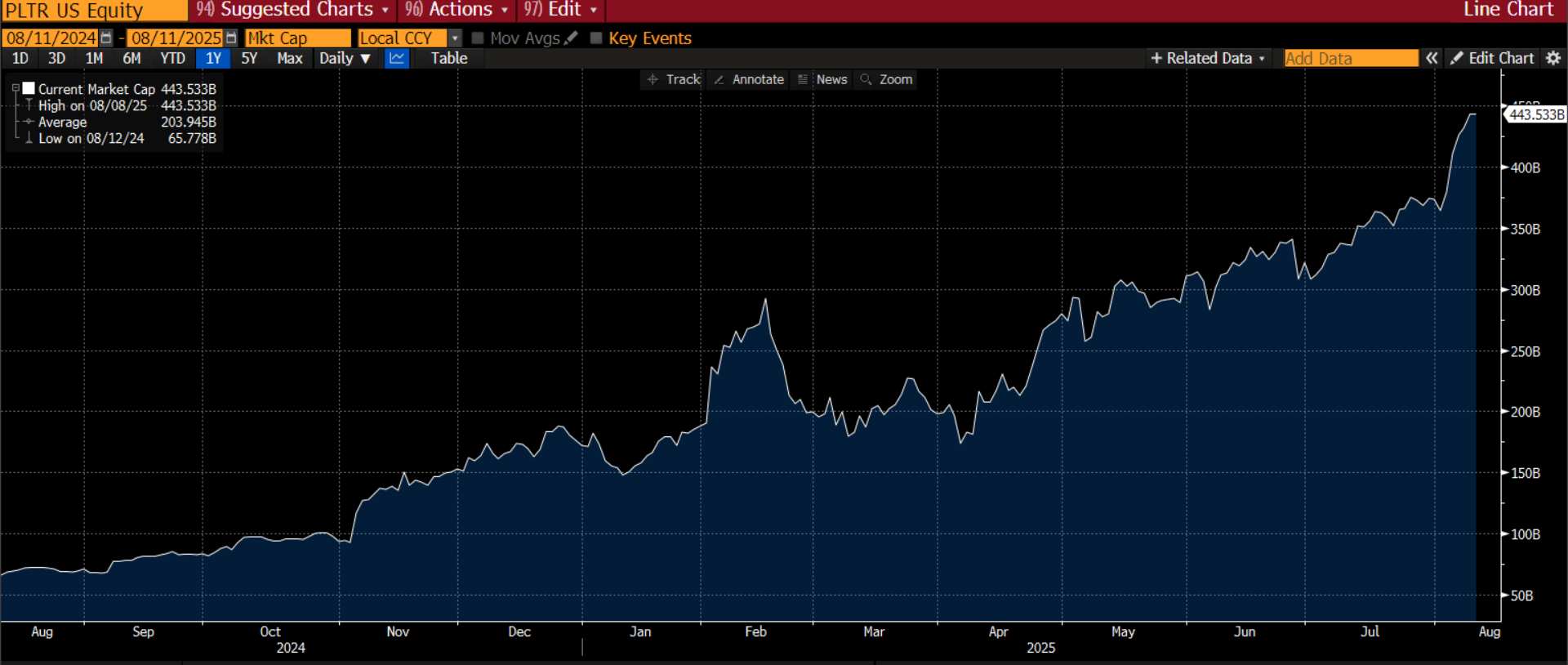As we start a new week, stocks are mildly higher on both sides of the Atlantic, as investors remain cautious ahead of some key economic data scheduled for release this week; however, investors are also reluctant to give up on the recent stock market rally. The oil price is extending declines as we wait for the meeting between President Trump and Russian President Putin in Alaska this Friday. The price of Brent crude oil has fallen more than 3.8% in the past 5 days, as the erosion of the war premium and hopes for a positive outcome that could boost oil supply weigh on prices.
A positive outcome from the talks could see sanctions removed from Russian oil, which may exacerbate the supply glut forecast for 2026. For now, this is having a positive impact on stocks, although the energy sector in Europe and the US could come under pressure.
Trump causes volatility in the gold market
A few themes are emerging as we move into a new week. Tariffs remain a key concern. The focus is now on China, their tariff exemption will expire this week, although it is expected to be extended yet again. There is also a potential gold levy. We are still waiting to hear about sector specific tariffs for the likes of pharma and semiconductors. The impact of tariffs on US inflation will also be in focus with the US CPI report for July. The spectre of stagflation is hanging over the US economy, after last month’s service sector ISM saw activity stall and the prices paid component rise to its highest level since 2022.
Nvidia and AMD give in to Trump
The tech sector will be in focus on Monday, as investors digest news that Nvidia and AMD, the US chip makers, have agreed to give the US government 15% of revenues from sales of their chips to China. This is an unusual step, but the quid pro quo will be obtaining export licenses for semiconductors so that US companies can sell into China. The US Treasury must be rubbing their hands with glee, as this could be a nice revenue generator in the years to come. Nvidia sales of H20 chips to China are forecast to be more than $20bn per year.
This news could be welcomed by investors, as small price to pay for access to China’s market. Apple’s share price soared last week and rose more than 8%, after the company agreed to invest an extra $100bn in the US, which was warmly celebrated by the President at the White House.
In early trading, US stock futures are down slightly at the start of this week as investors wait for some key economic data. Stocks could trade sideways at the start of this week, as we wait for key economic data like US inflation. If the CPI report opens the door to stagflation in the US economy, then it makes the Fed’s Jackson Hole meeting on 21-23rd August all the more interesting from a market’s perspective.
There was confusion in the gold market at the end of last week, after some investors had assumed that imports of gold bars would be exempt from tariffs, it turns out there is no such exception for 100 ounce bars. This means that gold bars of this weight from Switzerland, which is one of the world’s largest exporters of gold, will now face a 39% tariff upon entry to the US. This caused US listed gold prices to surge, while London listed gold remained stable. The price of gold in the US reached a record, but it is pulling back in early trading at the start of this week. The President is set to issue a clarifying statement on levies on gold bars in the coming days, which could calm investors’ minds. This is why the gold price is retreating at the start of the week. Gold is down more than 1% in London, and Comex gold futures in New York are lower by more than 2% today. There may be a silver lining. Even though tariffs at this rate will likely halt the flow of gold to the US, it can be redirected to other parts of the world where gold demand is higher. It could also go some way to reducing Switzerland’s trade deficit with the US, which has caused so many issues for the Swiss in securing a trade agreement with President Trump.
A successful Q2 earnings season
We have now passed the peak for Q2 earnings season, which makes it easier to give accurate assessments of the Q2 earnings performance. The news is good for the US, it is reporting double digit earnings growth for the third consecutive quarter, which helps to justify the strong performance for US stocks in the second half of this year. After a dismal start to 2025, US stock markets are on fire. The S&P 500 rose more than 2.4% last week, and the Nasdaq jumped by just under 4%, to a fresh record high.
Strong results from Palantir, including a 48% increase in revenues compared to the prior year, pushed the stock price to a fresh record high last week. Its market capitalization is now $448bn, and has jumped by $270bn since April, as you can see below. It’s 12-month forward P/E ratio is more than 250 times earnings. This is worrying some investors, however, Palantir enthusiasts say that this elevated valuation is justified by a stunning results and a strong pipeline of contracts, including a new $10bn contract for the US defense department. Thus, it is hard to call a peak in tech stocks.
Chart 1: Palantir market capitalization

Source: XTB and Bloomberg
So far, the S&P 500 is reporting an 11.8% YoY earnings growth rate, and 9 out of 11 sectors are reporting positive earnings surprises, led by communications, tech and financials. In terms of revenue growth, the healthcare, tech and communication sectors are leading the way, and only the energy sector has reported weaker revenues compared to a year ago.
How stocks perform later this week could depend on some key economic data reports. We pick the three key events to watch in the coming days.
1, US inflation
The CPI report for July is one of the data highlights this week. The market is expecting a moderate rate of price growth in July, with the headline month-on-month rate is expected to expand by 0.2%, the core rate is expected to rise by 0.3%. The annual rate for headline CPI is expected to inch up to 2.8% from 2.7% in June, while the core rate is expected to rise to 3% from 2.9%.
The July and August inflation prints will be important ahead of the September Federal Reserve meeting. Currently there is an 88% chance of a rate cut at this meeting, after the weak payrolls report for last month. A higher-than-expected inflation print could temper some of these expectations, as only two members voted for a rate cut at the July meeting, with the bulk of members voting to hold rates steady.
The focus will also be on the impact from tariffs. Firms have been laying the groundwork for tariffs, by raising prices in recent months, although that could fall back in July, with bigger items seeing a slowdown in price growth, even though smaller items like toys could still face some passthrough. The US has received the largest amount of customs duties from Chinese imports so far this year, so products that are imported from China could see the largest inflationary impulse last month. The recent increase in customs duties could be a one-off event, with price growth easing last month. However, if price increases are higher than expected, we could see expectations for a September rate cut get scaled back, which may boost the dollar, which is under pressure as we start a new week.
2, UK labour market data
There are growing signs that the UK labour market is coming under pressure, especially the private sector. The latest survey data from the Chartered Institute of Personnel and Development reported that hiring intensions in the private sector are at a record low, with only 57% of private sector firms planning on recruiting in the next 3 months, down from 65% a year ago. This comes as businesses are worried about potential tax hikes in the autumn budget, and young people are hit the hardest. Other survey data from KPMG found that hiring fell sharply last month, with the steepest decline in vacancies since April. This is also hitting starting salaries, which are rising at their weakest rate in 4.5 years.
There are concerns that the upcoming Employment Rights Bill could hit the private sector hard and erode hiring intensions even further. Thus, Tuesday’s hard labour market data from the ONS is worth watching closely. It is expected to show a further cooling in the labour market and stagnation in private sector wage growth, as the gap between public sector and private sector pay growth is expected to continue to widen. The unemployment rate is expected to remain steady at 4.7%, while public sector wage growth is expected to come in at 5% for the three months to July, with private sector wage growth at 4.8%. Jobs growth is also under the spotlight, as jobs have been shed at a rapid pace in recent months. This is expected to continue, although the pace of job losses could slow.
Overall, this data is expected to show more weakness creeping into the UK economy, which is unlikely to abate until after the Budget in late October/ early November.
3, UK Q2 GDP
It could be a double whammy of bad economic news for the UK, which may weigh on the pound later this week. The Q2 GDP figure is released on Thursday, and it is expected to show that growth was a mere 0.1%, a sharp slowdown from the 0.7% recorded in Q1. Part of this dramatic slowdown is tariff related, with production and activity front-loaded to the start of the year to avoid the expected tariffs that came into force in April.
This could knock the pound, which has been the best performing G10 currency so far in August. At the start of the week, UK bonds are outperforming their European peers, and UK yields are falling on Monday. The 2-year yield is down 4bps so far this morning, as the bond market prices in expected weak economic data from the UK. This has weighed on GBP/USD, which is backing away from the $1.3480 highs from earlier.
Weakness is expected in personal consumption, business investment and in trade, with only government spending propping up the UK economy last quarter. This data could add pressure on the chancellor to consider the balance of tax and spend in this Autumn’s budget.
Daily Summary: Wall Street ends the week with a calm gain 🗽 Cryptocurrencies slide
NATGAS surges 5% reaching 3-year high 🔎
Bitcoin loses 3% 📉Technical bearish flag pattern?
3 markets to watch next week (05.12.2025)
This content has been created by XTB S.A. This service is provided by XTB S.A., with its registered office in Warsaw, at Prosta 67, 00-838 Warsaw, Poland, entered in the register of entrepreneurs of the National Court Register (Krajowy Rejestr Sądowy) conducted by District Court for the Capital City of Warsaw, XII Commercial Division of the National Court Register under KRS number 0000217580, REGON number 015803782 and Tax Identification Number (NIP) 527-24-43-955, with the fully paid up share capital in the amount of PLN 5.869.181,75. XTB S.A. conducts brokerage activities on the basis of the license granted by Polish Securities and Exchange Commission on 8th November 2005 No. DDM-M-4021-57-1/2005 and is supervised by Polish Supervision Authority.


